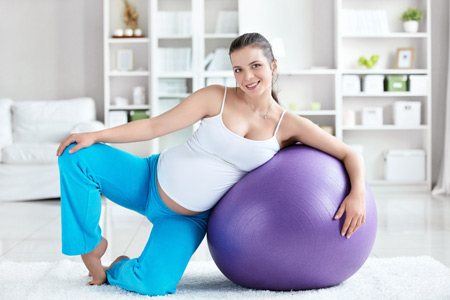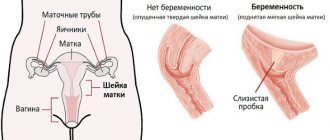How was childbirth a few decades ago? From the stories of our mothers and grandmothers, we know that from the beginning of labor and throughout the entire birth, the woman lay in bed. But giving birth only lying down is not always convenient and effective; there are other ways to experience contractions, and they very often help to significantly reduce labor pain.
In the old days, during labor, a woman had to go around the entire house, open all the locks, drawers, doors and untie all the knots. This meant the symbolic opening of the birth canal and the woman’s readiness for childbirth. It turns out that before the woman moved during contractions, because by the time you open everything and untie it, enough time will pass.
Active movement to ease contractions
During contractions, especially in the active phase of the first stage of labor, when the contractions are strong, you need to take a comfortable position. walking is great for this . You need to move at your own pace, calmly, without sprinting. You can walk from the first contractions until you have the strength, periodically you can rest, and then resume movement again. The gait can be anything - you can waddle like a duck, rotate your hips, walk with your legs wide apart. Any option will do - the main thing is that it should be comfortable. dance help relieve labor pain .
Important: do not move abruptly, move smoothly and slowly. To relax while dancing or walking, you can turn on your favorite music (for example, listen to it from your phone or tablet).
Psychological pain relief for childbirth
No matter how strange it may seem, a woman’s positive psychological attitude is an excellent way to significantly reduce pain during the birth of a baby. If the expectant mother is psychologically ready for the process itself, if she does not “wind up” herself, does not “squeeze” and wait for pain, then everything will go much easier. It has already been proven that with the onset of contractions, many women begin to feel pain only because they are waiting for it. Instead of getting ready for serious work and helping the baby to be born as soon as possible, they begin to be intensely afraid of pain. Self-hypnosis, you see, is a serious thing. However, we will not deny that many women, due to some individual characteristics, actually experience severe pain.
What can be advised in these cases? Relax. Believe me, wise nature also took care of pain relief during childbirth, but women sometimes harm themselves. A pregnant woman must realize and firmly get it into her head: the more she tightens, the more painful it will be for her. And vice versa: pain will be minimal if the woman can relax. If you become familiar with breathing techniques that promote relaxation before giving birth, master them, and apply the acquired knowledge at the onset of labor, then you can pass this exam with an A plus. After all, in a calm state, a woman in labor produces a sufficient amount of endorphin hormones, which can reduce unpleasant physical sensations, help relax, reduce pain and have a beneficial effect on the course of labor. It is also important to listen to the advice of an obstetrician-gynecologist who “commands the parade”, then you can significantly alleviate the condition.
Many women find massage to cope with the pain of childbirth. It is especially good to stimulate points located in the buttocks and sacrum. Moreover, a warm bath can help you relax. This is relevant if the woman is still at home or if the conditions in the maternity hospital allow her to take a bath. This procedure helps to relax during contractions, relieve tension in the muscles, back and joints.
How to relieve pain during contractions in water
Staying in water is a great way to relieve pain during contractions. In water, Archimedes' law acts on our body - the liquid simply pushes the woman out, she does not feel the weight of the body and perceives the water as a massage. Warm water warms up the muscles of the back and abdomen, they relax, and the birth canal relaxes - as a result, pain decreases. A bath is taken in the first stage of labor (labor), this can be done both at home and in the maternity hospital - today many birth boxes are equipped with a bathtub or at least a shower . In any case, water will have a relaxing effect on the woman in labor.
Important: you do not need to take a very hot bath, even if it seems that the heat helps you better endure contractions, the water temperature should be comfortable.
How to reduce fear of childbirth?
1. The unknown is known.
Everyone is afraid of the unknown and uncertainty. If you know the main stages of childbirth, have an idea of what awaits you in the prenatal period, what contractions and pushing are, how to breathe correctly, you will be much easier and calmer.
It is best to take a course on preparing for childbirth, but you can also talk with friends who have given birth, read information on the Internet, and read special literature on this topic.
Choose in advance the maternity hospital where you are going to give birth. Find out about the features of this establishment. Find out what the conditions are there. If you are very worried, choose the doctor with whom you want to give birth and discuss all the nuances with him, ask questions.
2. Pain is an ally, not an enemy.
Many people fear pain during childbirth, but pain is a part of childbirth. By following special breathing techniques during childbirth and relaxation methods, you can endure the pain, reduce it and still have the strength to push.
But you shouldn’t scream or silently endure the pain with clenched teeth, as you will only prevent the cervix from opening and lose a lot of strength.
Pain is an advisor who will tell you when you need to relax, change position or take a certain position for the most comfortable passage of the baby through the birth canal.
3. The alarm case is ready!
It is much easier to prepare for the start of labor when you know that you have everything ready. Pack your things for the maternity hospital in advance according to the list (lists are available in the maternity hospital, antenatal clinics, from friends who gave birth, or on the Internet).
Decide how you are going to go to the maternity hospital (call an ambulance or your spouse can take you), which route (so as not to get stuck in traffic).
Prepare yourself mentally for any situation, for example, your water breaks in the store or contractions start while walking. Don't worry, you will manage everything, you have time. You will be able to go home or ask to be picked up. The main thing is don't panic.
4. A positive attitude is the key to success!
Pray, meditate, sing. Imagine your baby as you press him to your chest, kiss him and hug him. Think positively, do not use the word “not”.
5. Husband’s support – in what way?
Think in advance whether you want to see someone close to you (husband, mother) during childbirth. What kind of help do you expect from them? Are you going to have a partner birth or not? Just remember that your loved ones will not read your thoughts. You need to explain what and when you want them to do.
6. Oh this head!
During childbirth, you don’t need to think about how the birth will end quickly, don’t rush things. Your body knows what, how and when it needs. Let him act.
How to use a fitball to ease contractions
Many maternity hospitals today use a fitball , a rubber inflatable ball commonly used for aerobics, to relieve labor pain. With the help of a fitball, you can take a variety of poses: swing, rotate your pelvis, spring, roll from side to side, sitting on the ball. You can also kneel down and lean your arms and chest on the ball, rocking back and forth. Sitting on the ball, the woman in labor takes a vertical position, and this contributes to better dilatation of the cervix. In addition, riding while sitting on a ball affects reflexogenic zones and reduces the pain of contractions.
Important: the ball should not be fully inflated - it is comfortable to sit on such a ball, you cannot roll off it, as with a maximally inflated ball, the position on such a not fully inflated ball does not interfere with the advancement of the child’s head.

Don't be embarrassed to look stupid during childbirth. No one in the delivery room cares how you move if it helps you get through contractions. There is nothing funny, ridiculous, and even more so stupid in any type of movement during childbirth. In the birth block you won’t surprise anyone with anything.
What helps reduce the pain of contractions
Attitude is important
There is an opinion that pain during childbirth can be reduced to zero. I have not met women who did not experience pain at all, but everyone unanimously repeats in the reviews that rumors about the pain of contractions are exaggerated. And most importantly, after giving birth, a woman quickly forgets these experiences.
Therefore, let's agree that we will not be afraid and will have a positive : if you do not shrink in fear of what is coming, then nothing painful will happen.
Relax and have fun! You are about to meet your baby - think about it! And you will also get rid of that boring belly and become light and airy again!
Movement
Previously, women were prohibited from getting out of bed during labor. Poor things! After all, it is known that tension in any muscles is easier to overcome or relieve by moving .
You can and should walk ! In ancient times, women did not lie down at all during childbirth - children came out more easily under the influence of gravity, so they gave birth on their haunches or in special chairs. And recumbent childbirth was invented, they say, for one curious French king who wanted to see how it happens.
Today, doctors recommend walking, doing exercises, and even dancing while waiting for the uterus to open.
Ball
The fitball is great for helping with contractions. Only it should not be fully inflated so that the ball is soft. Then it is comfortable to sit on it, swing, spring, rotate the pelvis, roll, which relaxes the muscles and helps accelerate the dilation of the cervix.
Reviews of postpartum women about childbirth with a fitball say that it is very effective and does not at all interfere with the baby’s progress through the birth canal. Tested by personal experience!
How to breathe correctly
Correct breathing is the main assistant . There are different, often conflicting, tips on how to breathe during contractions. But personally, this video helped me a lot
Here we talk about two methods that will be quite sufficient during labor to facilitate the process:
- breathing during contractions;
- breathing while pushing.
The main message: breathing should be comfortable, so that a woman can breathe during contractions without thinking about how she does it. The main goal is relaxation, plus saturation of tissues with oxygen.
I liked this technique right away. I used it when I had my second child. And I can say that with such breathing it is much easier to survive pain during contractions.
“Hanging” the belly
As the contractions intensify, you can take positions in which the stomach is as if in a “suspended” state. This way, the weight of the uterus will put less pressure on large blood vessels, and consequently, uteroplacental blood flow will improve. In addition, the load on the spine is removed, which will reduce pain.
You can simply lean forward and lean against a support that comes to hand - a table, chair, headboard, window sill. Some maternity hospitals have wall bars and ropes attached to the ceiling. During a fight, you can hang on them, leaning on a wall or rope. Previously, special tension ropes were used almost everywhere, although they were secured not to the ceiling, but to the foot of the bed. During contractions, the woman in labor pulls on the rope with all her strength while kneeling. In partner childbirth, you can use positions that allow you to transfer your body weight to your partner. You can hang on your husband’s neck or lean on him.
What to do if you have to give birth lying down?
Sometimes, for medical reasons, a woman needs to give birth in a horizontal position. In this case, you do not need to lie on your back, since in this position the large uterus compresses large blood vessels - as a result, the blood supply to the child worsens. It is better to lie on your side with something under your chest and between your legs, such as a pillow or blanket. In modern maternity hospitals, instead of traditional beds, there are transformable beds . On such a bed, a woman in labor can take a position that is comfortable for herself, choose its height, lower or raise one of its ends - and therefore make it easier to experience contractions.
You can show your imagination and come up with your own poses that are convenient for you. It is only important that they help you relax, are stable and safe.











